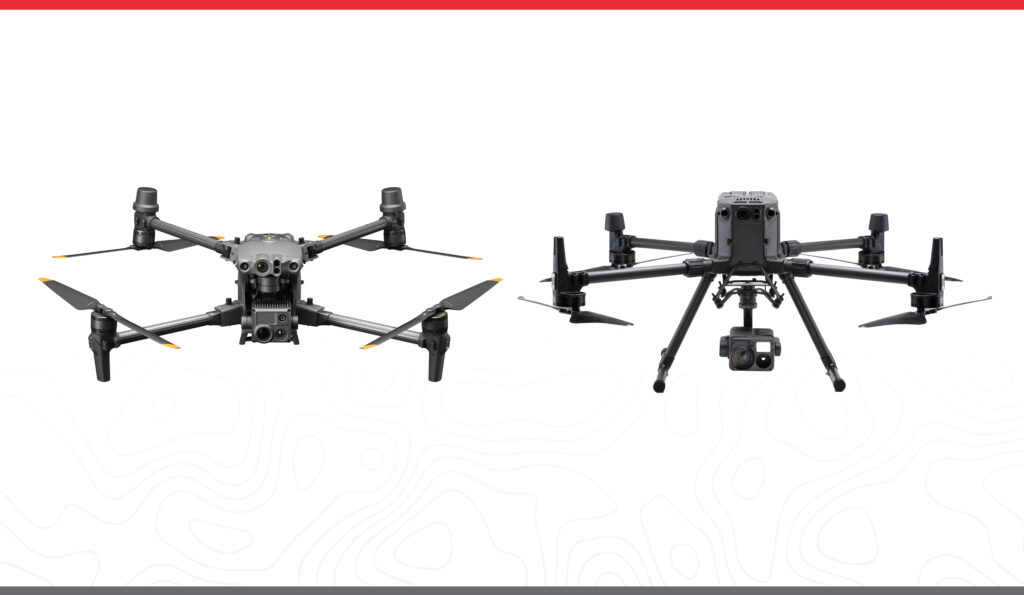
A market survey reveals that DJI drones dominate the public safety sector; more than 90% of disaster response drone programs put their trust in DJI drones. DJI drones have saved over 940+ souls, have had a massive impact in 551+ rescue incidents, and have been deployed in over 39+ countries – these numbers are on the rise. I’m not sure if we could find a more impressive track record as DJI when it comes to drones in times of grief. The applications of drones in Public Safety initiatives include Firefighting, Law Enforcement, Rescue Services, Disaster Management and more.
Our experts confirm that M30T can be in the air in less than a minute; Of course, why not? Straight out of the bag… Propellers unfolded… RC on – That’s it; M30T is flying already! The pack-up is even simpler; switch it off… fold it down… pack it up – you are off to the next mission field!
Whereas M300 RTK will require almost 5 minutes for the set up alone – first, you will need to fit the landing gear, assemble the legs and attach the payloads to start off. As you might have guessed by now, pack-up is also a little time-consuming (comparatively) as you have to dismantle the drone equipment before you move to another location for the safety and security of the sensors, especially.
The DJI M30T is half the weight of the DJI M300 RTK. Apart from that, one of the most notable aspects of DJI M30T is its highly compact and foldable design, because of which M30T can fly into tiny spaces, which was previously unattainable by enterprise drones. With enterprise drones, we may struggle with squeezing the drone into the car’s trunk. But guess what? The M30 can even fit a backpack! As a result, the operators don’t have to waste their energy or time figuring out how to transport the drone; and this convenient transport of M30T translates into crucial time savings.
The DJI M300 RTK gives you an impressive flight time of 51 minutes without payloads (43 minutes with H20T). Meanwhile, the M30 has a slightly lower flight time of 41 minutes. From what we have seen, to be honest, you shouldn’t be relying solely on these numbers given by DJI; they are tested in optimal conditions. However, it is safe to say that 30 minutes for any operation is pretty impressive & usually more than enough. Likewise, we found that hot-swapping on the M30T is super easy compared to that of the M300RTK.
DJI M300 is IP45-rated, and turbulence and wind speed up to 15 m/s won’t affect the drone. On the other hand, the DJI M30T has an improved, in fact, the highest IP Rating – IP55, and wind resistance up to 15 m/s.
Our best impression about the M30T is definitely its ‘Portability‘, and M300 RTK its ‘Versatility‘.

It is right to conclude that if you have an emergency mission where you have to quickly do a thermal scan, we would recommend you to go with DJI M3OT – provided that the mission area and weather are favourable. But for critical missions in unpredictable weather, DJI M300 is undoubtedly the best. It gives us more visibility into the scene as you can simultaneously mount up to three payloads of varying capabilities, that too with a total take-off weight of 9 kg.
In fact, the M30 and M300 RTK both have their place in a drone fleet. The M30 Series is an extremely capable drone – with excellent balance of power, portability, performance and price. On the other hand, when it comes to performance, the M300 RTK remains the standout in DJI’s enterprise lineup. So we believe, as far as the Public Safety sector is concerned, the right way to perceive M30 is as an operations escalator that offers an invaluable addition to the existing drone fleet rather than an alternative to the current drones.
Please get in touch with the Drone Centre to add these life-savers to your drone fleet. Our experts can guide you through the entire process, from consultation to helping you find the right drone, training your staff, and supporting your entire team to achieve excellence in your drone operations. Intrigued? Perfect, feel free to drop us a line!